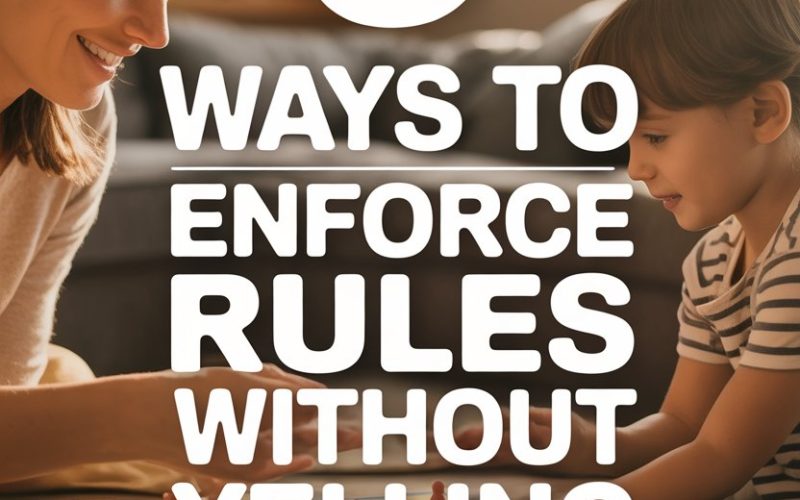Ever feel like you’re one “put your shoes on!” away from starring in your own mum- or dad-sized Godzilla movie?
Parenting comes with a side of volume control issues—especially when it feels like the only way to get kids’ attention is to crank your voice up to eleven.
The good news: enforcing rules doesn’t have to involve lost voices, sore throats, or that familiar twinge of guilt for shouting.
Whether you’re wrangling toddlers or tweens, there are proven approaches that work (and might even save your vocal cords).
Time for less yelling, fewer tears, and a lot more calm.
1. The Power of Consistent Routines
Picture this: you announce bedtime, and your child marches up the stairs, brushes their teeth, and climbs into bed without a peep.
Ha! I know. But here’s the thing—routines really can create miracles, or at least avoid bedtime negotiations that make Brexit look straightforward.
Children thrive on routine. When they know what’s coming next, and what’s expected, the battle lines blur.
Psychologist Dr. Laura Markham suggests that structure makes kids feel safe and secure, and that routine is a silent, reliable enforcer of rules.
Announce routines ahead of time. Use visual schedules for younger children—pictures of breakfast, getting dressed, and school runs bring predictability.
For older kids, a written checklist (bonus points if you let them help make it) does wonders.
Slip in some humour. “Do you want to hop like a frog or slither like a snake to bed tonight?” Suddenly, you’re less drill sergeant, more zookeeper.
When routines become habits, reminders morph from “I TOLD YOU TO BRUSH YOUR TEETH!” to “What’s next on our list?”
Less yelling required. Everyone wins (even your neighbours).
2. Speak Softly, Carry Clear Expectations
Ever notice that when you whisper, kids are suddenly all ears? It’s like some ancient magic—lower the volume, and children lean in, curious about what you’re saying.
Instead of raising your voice, focus on clarity. Tell your kids exactly what the rule is, what will happen if it’s not followed, and stick to it. “Shoes stay on the rack. If they’re not, we can’t go to the park after tea.”
Direct, calm, non-negotiable—no need for extra decibels.
Experts like Dr. Alan Kazdin from Yale suggest the “when-then” method: “When you pick up your toys, then we’ll read your favourite story.”
It frames the rule as a simple cause and effect, rather than a power struggle.
Reserve serious voice for serious things. If you yell at every little infraction, your voice blends into the background noise. Speak calmly, even when you’re fuming inside.
That unexpected calmness might just get their attention—and their respect.
One tip from parents in the trenches: Get down to their level. Eye contact does half the heavy lifting.
3. Natural Consequences: The Universe as Teacher
The universe is the original disciplinarian. Forget abstract threats (“You’ll be grounded for a month!”) and let real-world consequences do the work.
If your child leaves their coat outside and it rains, guess who has a soggy jacket the next day? No need for a lecture worthy of Oscar consideration—just a sympathetic, “That’s a shame. Wet coats aren’t much fun, are they?”
Next time, you might find them hanging up their things without being told.
Research from Positive Discipline shows that natural consequences are much more effective (and memorable) than arbitrary punishments. Why? Kids see the logical results of their actions, not just a parent’s frustration.
Of course, safety comes first. Don’t let “natural consequences” mean letting them play in traffic or eat a questionable sandwich from last week’s lunchbox. But life serves up plenty of safe, teachable moments.
It’s tempting to swoop in and save the day (or the homework assignment left on the kitchen table). Every once in a while, let the universe have its say.
Your child might surprise you with how quickly they learn.
4. Positive Reinforcement: Catch Them Being Good
Yelling often happens when we’re frustrated by what’s going wrong. What if you spent twice as much energy noticing what’s going right?
Praise is rocket fuel for good behaviour. It doesn’t need to be over the top (“You are the Mozart of sock-folding!”), but a simple “I noticed you put your dishes away!” can work wonders.
According to child development experts, positive reinforcement encourages kids to repeat the behaviour you want to see.
Make it specific. “Thanks for coming to the table the first time I asked,” is much more effective than a generic “good job.”
Kids love attention, and if they get it for following rules, you’ll see more of it.
For younger children, sticker charts or a marble jar can turn rule-following into a game. For older ones, a spontaneous privilege (“You finished your chores—want to pick the film tonight?”) speaks volumes.
Positive attention is a lot easier on the nerves than negative attention. Not to mention, it’s much more pleasant to dole out stickers than to raise your voice.
5. Emotional Coaching: Name the Feelings, Tame the Storm
Yelling is often a sign that everyone’s feelings are running high—yours included. Emotional coaching is the parenting equivalent of having a fire extinguisher on hand.
When you help your child name what they’re feeling, you teach them to handle big emotions without resorting to banshee-level shrieking (on either side).
Clinical psychologist John Gottman found that kids whose parents practice emotional coaching have better self-control and fewer behaviour problems, even when rules are enforced.
Here’s how it works:
Your child is melting down about the fact that bath time is ending. Instead of barking, “Enough! Stop crying!” try: “You’re sad because you wanted to play longer. It’s hard to stop when you’re having fun.”
Pause. Let them process. Then redirect: “Bath’s over, but maybe we can pick a bedtime story together.”
This doesn’t mean indulging every whim or backing down on rules. It’s about showing that you’re on their side, even if the rule stands.
And yes, sometimes you’ll need to coach yourself through your own feelings. Take a big, silent inhale.
Channel your inner yoga instructor. “I’m cross because we’re late, and I wish you’d put your shoes on the first time. But yelling won’t help.”
If you mess up? Apologise. “I shouldn’t have shouted. I was frustrated, but I want to do better.”
Kids learn as much from your repair work as from your calm moments.
Yelling Less, Connecting More
No parent on earth has managed to keep a completely calm head forever (if they claim they have, check for suspiciously angelic children and/or a suspicious lack of felt-tip pen stains on the furniture).
Yelling happens to the best of us.
But with a few tweaks—clearer routines, quiet confidence, natural consequences, a sprinkle of praise, and a dollop of emotional coaching—you really can keep the volume down and the connection up.
Your kids might not notice your peaceful Zen at first. They might even try to test the new system (“Mum, are you feeling alright?”). Stick with it.
Over time, you’ll find your home settles into a quieter, kinder groove.
And your vocal cords will thank you.





